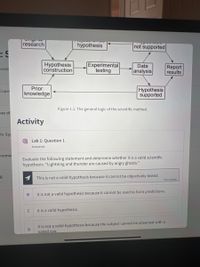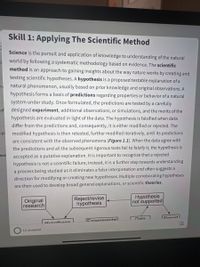
Human Biology (MindTap Course List)
11th Edition
ISBN: 9781305112100
Author: Cecie Starr, Beverly McMillan
Publisher: Cengage Learning
expand_more
expand_more
format_list_bulleted
Concept explainers
Topic Video
Question

Transcribed Image Text:Cnginu
research
hýpothesis
not supported
Hypothesis
construction
Experimental
testing
Data
analysis
Report
results
ienti
Prior
Hypothesis
supported
Exper
knowledge
Figure 1.1. The general logic of the scientific method.
pes of
Activity
ric Sys
Lab 1: Question 1
Answered
uremei
Evaluate the following statement and determine whether it is a valid scientific
hypothesis: "Lightning and thunder are caused by angry ghosts."
This is not a valid hypothesis because it cannot be objectively tested.
Your answer
It is not a valid hypothesis because it cannot be used to form predictions.
It is a valid hypothesis.
It is not a valid hypothesis because the subject cannot be observed with a
naked eve.

Transcribed Image Text:Skill 1: Applying The Scientific Method
Science is the pursuit and application of knowledge to understanding of the natural
world by following a systematic methodology based on evidence. The scientific
method is an approach to gaining insights about the way nature works by creating and
testing scientific hypotheses. A hypothesis is a proposed testable explanation of a
natural phenomenon, usually based on prior knowledge and original observations. A
hypothesis forms a basis of predictions regarding properties or behavior of a natural
ei
system under study. Once formulated, the predictions are tested by a carefully
designed experiment, additional observations, or simulations, and the merits of the
hypothesis are evaluated in light of the data. The hypothesis is falsified when data
of
differ from the predictions and, consequently, it is either modified or rejected. The
modified hypothesis is then retested, further modified iteratively, until its predictions
Sys
are consistent with the observed phenomena (Figure 1.1). When the data agree with
the predictions and all the subsequent rigorous tests fail to falsify it, the hypothesis is
accepted as a putative explanation. It is important to recognize that a rejected
hypothesis is not a scientific failure; instead, it is a further step towards understanding
mei
a process being studied as it eliminates a false interpretation and often suggests a
direction for modifying or creating new hypotheses. Multiple corroborating hypotheses
are then used to develop broad general explanations, or scientific theories.
Original
research
Reject/revise
hypothesis
Hypothesis
not supported
Report
Data
Experimental.
Hunotheeie
1/1 answered
Expert Solution
This question has been solved!
Explore an expertly crafted, step-by-step solution for a thorough understanding of key concepts.
This is a popular solution
Trending nowThis is a popular solution!
Step by stepSolved in 2 steps

Knowledge Booster
Learn more about
Need a deep-dive on the concept behind this application? Look no further. Learn more about this topic, biology and related others by exploring similar questions and additional content below.Similar questions
- A related set of hypotheses that collectively explain some aspect of the natural world makes up a scientific _________. a. prediction b. test c. theory d. authority e. observationarrow_forwardWhich of the following is not a feature of a scientific theory? a. It begins as a hypothesis. b. It eventually is accepted as absolute truth. c. It requires critical thinking. d. It is not accepted as a theory until it has been tested repeatedly.arrow_forwardFigure 1.6 In the example below, the scientific method is used to solve an everyday problem. Order the scientific method steps (numbered items) with the process of solving the everyday problem (lettered items). Based on the results of the experiment, is the hypothesis correct? If it is incorrect, propose some alternative hypotheses. Observation Question Hypothesis (answer) Prediction Experiment Result There is something wrong with the electrical outlet. If something is wrong with the outlet, my coffeemaker also won’t work when plugged into it. My toaster doesn’t toast my bread. I plug my coffee maker into the outlet. My coffeemaker works. Why doesn't my toaster work?arrow_forward
- Define and distinguish between: a. a hypothesis and a scientific theory b. an experimental group and a control grouparrow_forwardHow does the scientific meaning of “theory” differ from the common, everyday meaning of the word?arrow_forwardGive an example of how applied science has had a direct effect on your daily life.arrow_forward
- A person notices that her houseplants that are regularly exposed to music seem to grow more quickly than those in rooms with no music. As a result, she determines that plants grow better when exposed to music. This example most closely resembles which type of reasoning? inductive reasoning deductive reasoning neither, because no hypothesis was made both inductive and deductive reasoningarrow_forwardWhich of the following represents the application of the scientific method? a. comparing one experimental subject to one control subject b. believing an explanation that is too complex to be tested c. using controlled experiments to test falsifiable hypotheses d. developing one testable hypothesis to explain a natural phenomenon e. observing a once-in-a-lifetime event under natural conditionsarrow_forwardThe process of helps to ensure that a scientist’s research is original, significant, logical, and thorough __________. publication public speaking peer review the scientific methodarrow_forward
- Which of the following sequences represents the hierarchy of biological organization from the most complex to the least complex level? a. organelle, tissue, biosphere, ecosystem, population b. organ, organism, tissue, organelle, molecule c. organism, community, biosphere, molecule, tissue, organ d. biosphere, ecosystem, community, population, organismarrow_forwardThe type of logical thinking that uses related observations to arrive at a general conclusion is called _____________. deductive reasoning the scientific method hypothesis-based science inductive reasoningarrow_forwardThe type of logical thinking that uses related observations to arrive at a general conclusion is called_______. a. deductive reasoning b. the scientific method c. hypothesis-based science d. inductive reasoningarrow_forward
arrow_back_ios
SEE MORE QUESTIONS
arrow_forward_ios
Recommended textbooks for you
 Human Biology (MindTap Course List)BiologyISBN:9781305112100Author:Cecie Starr, Beverly McMillanPublisher:Cengage Learning
Human Biology (MindTap Course List)BiologyISBN:9781305112100Author:Cecie Starr, Beverly McMillanPublisher:Cengage Learning Biology 2eBiologyISBN:9781947172517Author:Matthew Douglas, Jung Choi, Mary Ann ClarkPublisher:OpenStax
Biology 2eBiologyISBN:9781947172517Author:Matthew Douglas, Jung Choi, Mary Ann ClarkPublisher:OpenStax Concepts of BiologyBiologyISBN:9781938168116Author:Samantha Fowler, Rebecca Roush, James WisePublisher:OpenStax College
Concepts of BiologyBiologyISBN:9781938168116Author:Samantha Fowler, Rebecca Roush, James WisePublisher:OpenStax College- Essentials Health Info Management Principles/Prac...Health & NutritionISBN:9780357191651Author:BowiePublisher:Cengage
 Biology: The Dynamic Science (MindTap Course List)BiologyISBN:9781305389892Author:Peter J. Russell, Paul E. Hertz, Beverly McMillanPublisher:Cengage LearningHealth Safety And Nutrition F/Young ChildHealth & NutritionISBN:9781305144767Author:MAROTZPublisher:Cengage
Biology: The Dynamic Science (MindTap Course List)BiologyISBN:9781305389892Author:Peter J. Russell, Paul E. Hertz, Beverly McMillanPublisher:Cengage LearningHealth Safety And Nutrition F/Young ChildHealth & NutritionISBN:9781305144767Author:MAROTZPublisher:Cengage

Human Biology (MindTap Course List)
Biology
ISBN:9781305112100
Author:Cecie Starr, Beverly McMillan
Publisher:Cengage Learning

Biology 2e
Biology
ISBN:9781947172517
Author:Matthew Douglas, Jung Choi, Mary Ann Clark
Publisher:OpenStax

Concepts of Biology
Biology
ISBN:9781938168116
Author:Samantha Fowler, Rebecca Roush, James Wise
Publisher:OpenStax College

Essentials Health Info Management Principles/Prac...
Health & Nutrition
ISBN:9780357191651
Author:Bowie
Publisher:Cengage

Biology: The Dynamic Science (MindTap Course List)
Biology
ISBN:9781305389892
Author:Peter J. Russell, Paul E. Hertz, Beverly McMillan
Publisher:Cengage Learning

Health Safety And Nutrition F/Young Child
Health & Nutrition
ISBN:9781305144767
Author:MAROTZ
Publisher:Cengage